How police officers on horseback patrol South Florida. Watch how they handle the crowds
The mayor of Miami Beach says he wants to bring police on horseback back to the city. The mounted patrol unit unit was disbanded in 1992.
Miami and Fort Lauderdale police maintain mounted patrols, and Miami-Dade previously had one.
What do mounted patrols do?
Let’s take a look through the Miami Herald archives at the officers and their horses.
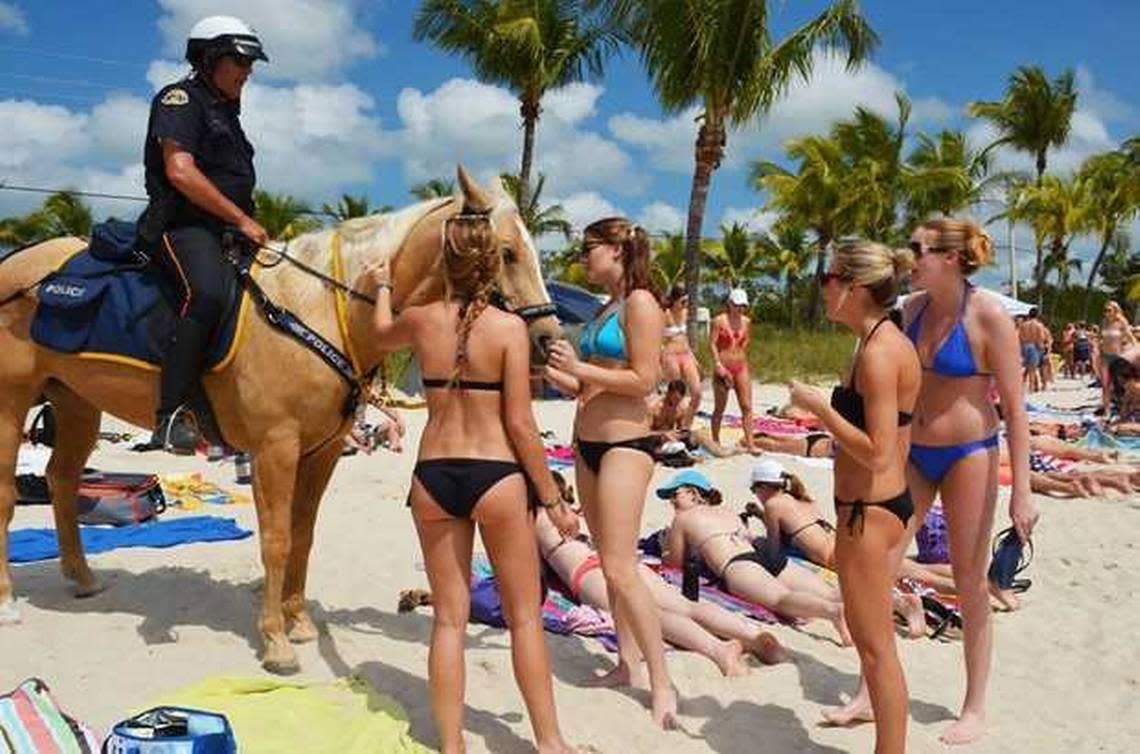
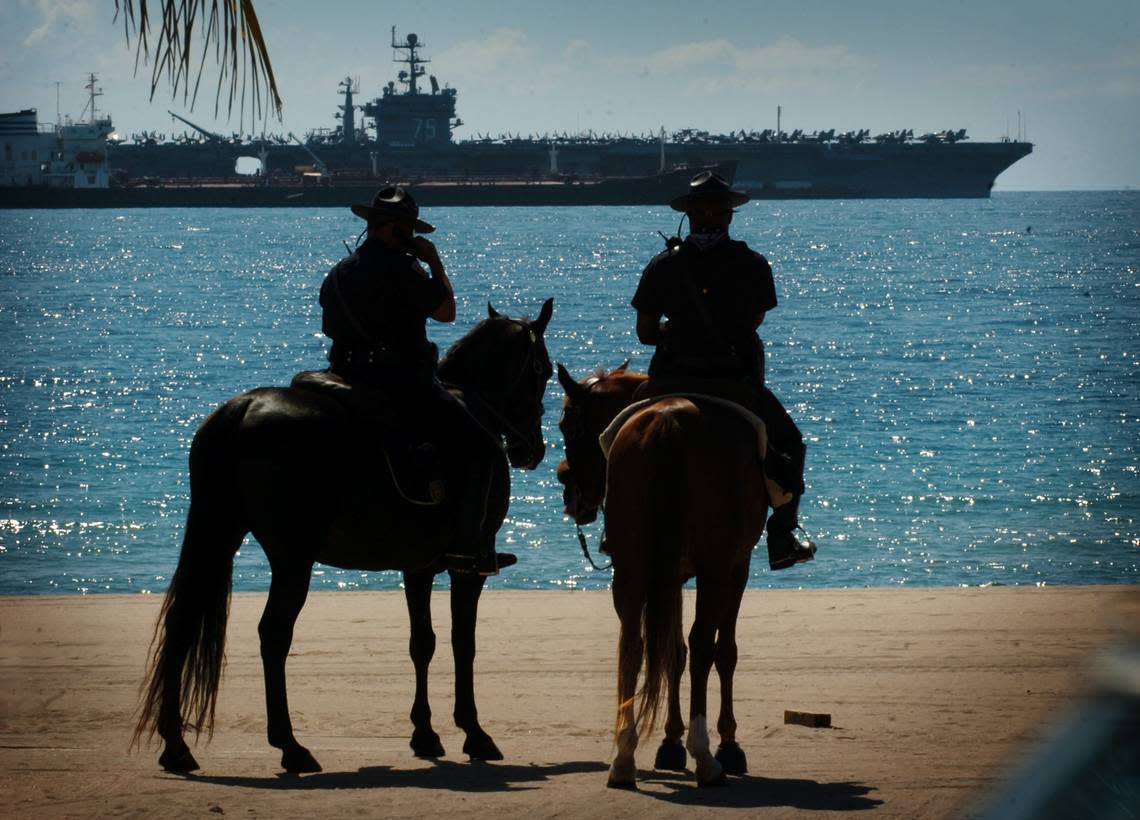
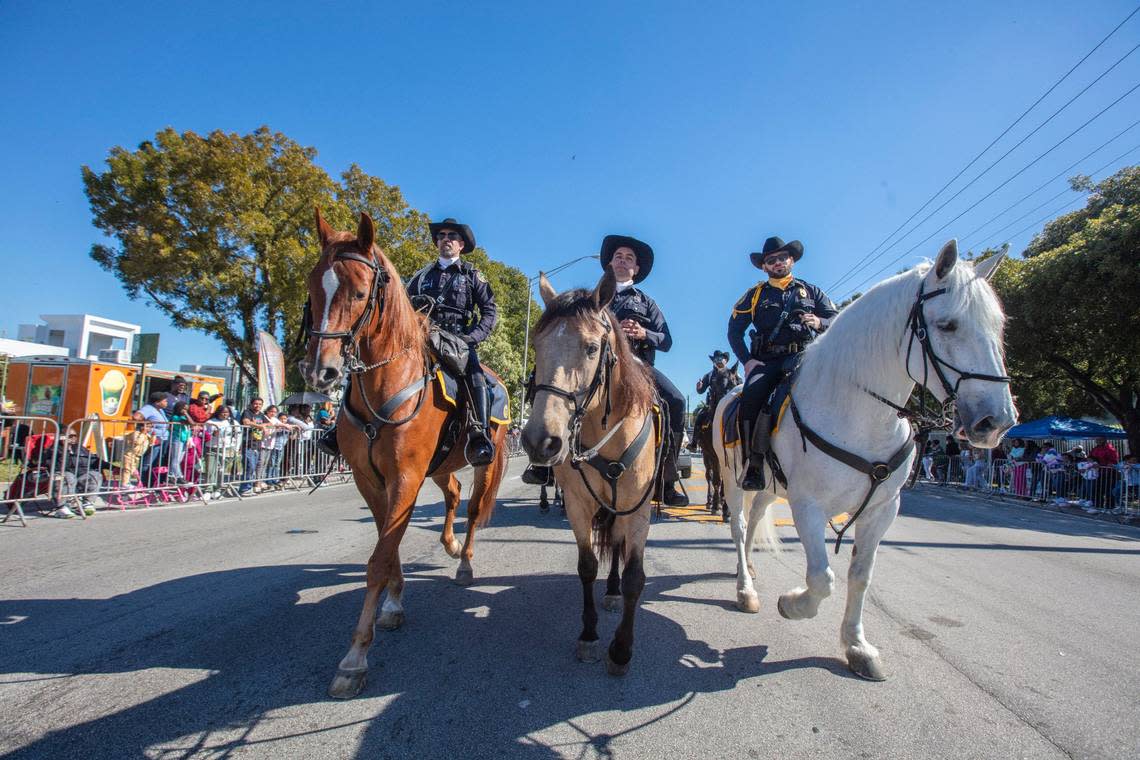
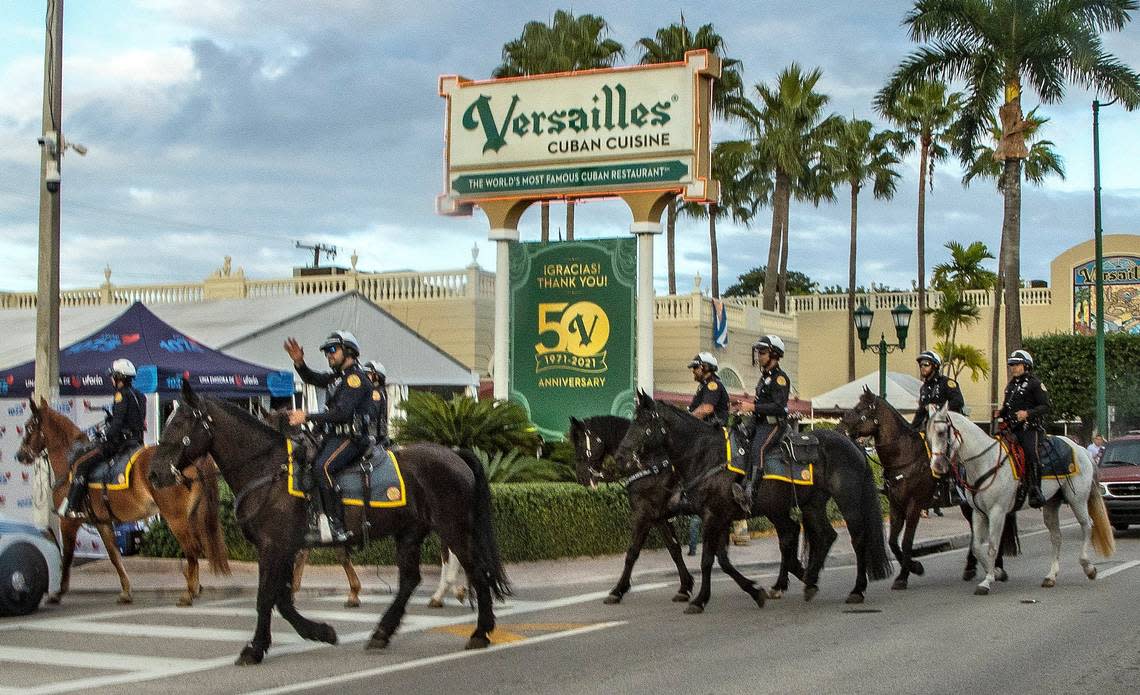
Horsepower on the holiday
Published June 17, 2015
By Carli Teproff
It was Memorial Day weekend, and Miami’s Hobie Beach was packed with people enjoying South Florida’s sun.
A call came into 911 reporting that a man was floating in the water, unresponsive.
Within minutes, Miami Officer Eduardo Perez was at the water’s edge - helping officers Orlando Guerra and Daniel Mogro revive the man.
Perez credits his speedy response to having “the best partner ever” - his horse, Panchito, “who flew through the sand” to get him to the ocean.
Panchito, a Morgan that has been on the force for about seven years, can do things human officers can’t: weave in and out of traffic; maneuver through difficult terrain, including sand and thick brush; help with crowd control; and give his human partner a better vantage point to solve crimes.
“I’m 10 feet tall when I am on him,” Perez said. “Horses add so much to policing.”
Miami has one of the few police departments in South Florida that still has a full-time mounted unit. Fort Lauderdale uses horses, and the Broward Sheriff’s Office has a volunteer unit.
“Some people think horse patrol is antiquated, but that is not the case,” Perez said.
In Miami, the horses are not only a public relations benefit - tourists love to take a photo with the mounted police officers - but they help write tickets and manage crowds.
Last year, the mounted unit, which includes 11 horses, wrote more than 2,000 citations last year and made 260 arrests.
On a recent Wednesday, Rodriguez mounted Panchito to do his rounds on Calle Ocho, first stopping at Domino Park in Little Havana. The horse easily weaved through the narrow paths.
He then walked out on the sidewalk just as a double-decker tour bus stopped on the street.
Ayrin Ruseva, who was from Germany, posed for a picture next to the horse.
“It makes you feel safe,” she said.
Unlike dogs, horses are allowed to eat on the job. Panchito is treated like a rock star in Little Havana. A woman gives Panchito three cut apples and three peppermint candies every day for helping to protect her neighborhood.
While other officers prefer cars, bicycles and motorcycles, Rodriguez said his choice will always be his four-legged partner.
“I only need one horse power to get me around,” he said.
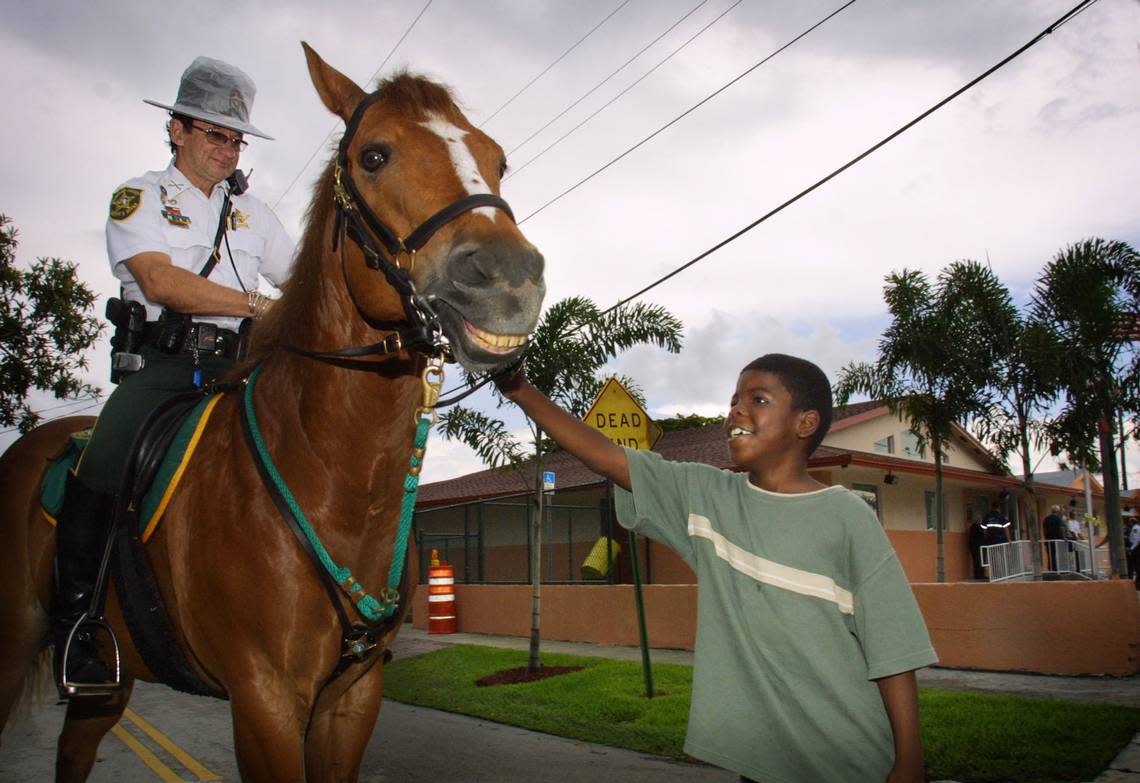
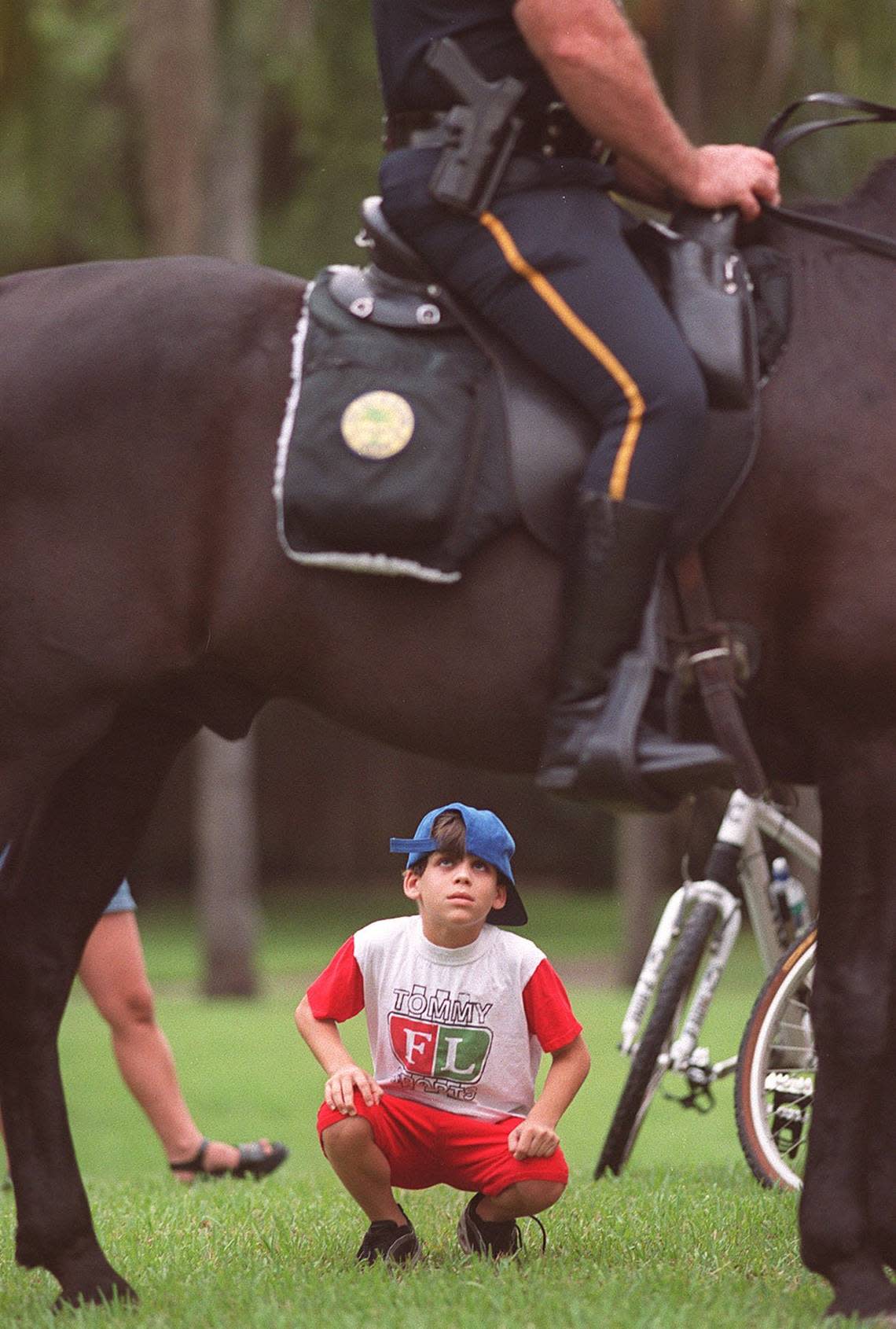
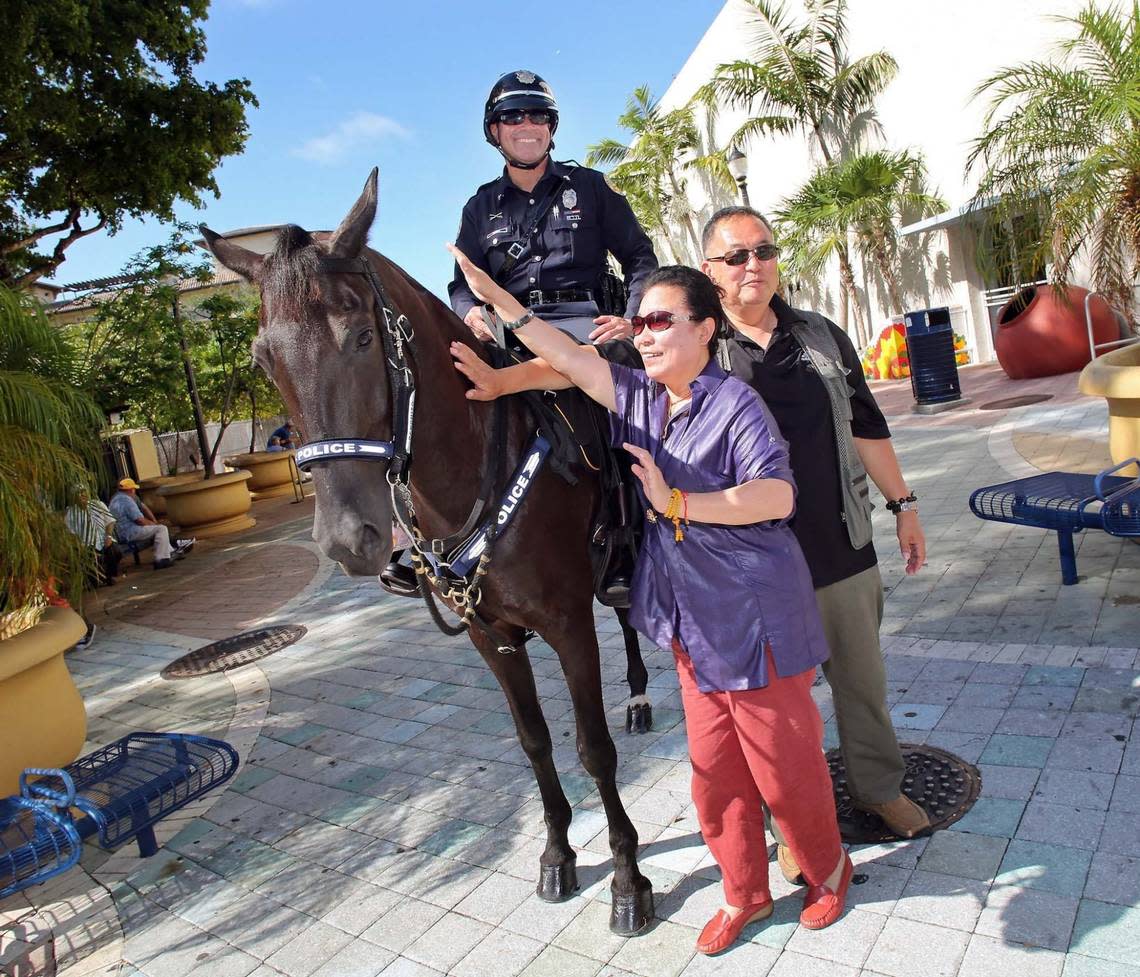
Closer to the public while on patrol
Published April 23, 1998
By Debra Franco
Some of Miami’s most popular police officers are easily bribed.
All it takes is an outstretched palm holding a carrot, celery stick, apple or their favorite -- sugar cubes.
In the era of ultra-high tech policing, an elite group of officers opted to trade in their air-conditioned, four-wheel cruisers for the four-legged kind.
Each morning, as rush-hour traffic swells to a peak, the clip clop, clip clop, clip clop of hooves on pavement echoes through Miami’s high-rise canyons.
“We are officers who are 10-feet tall,” said Officer Luis Ruiz, who trains the horses for the Miami Police mounted patrol unit. “An officer on horseback is a great combination.”
Indeed, officers perched in the saddle have a different view from atop their inner-city steeds, drawing attention from tourists and merchants and often scaring away potential criminals.
“When you show up to a call on a horse, the only thing the people remember is that the horse was there,” said Officer Alberto DeVelasco. “Not until I came here did I realize the amount of public relations we do.”
As DeVelasco rode through Coconut Grove recently, waiters left their sidewalk tables to offer his mount, Princess, a treat. Toddlers begged their parents for a chance to stroke Princess’ nose. And tourists stopped them constantly to ask for information.
“Oh wow! We don’t have anything like this in Oklahoma,” said Peggy Hulsey, from Tulsa, who was visiting relatives. “This is like, whoa. It’s good to know the police are accessible if we need anything.”
The mounted patrol unit’s role is the definition of community policing, DeVelasco said. Community policing is an increasingly popular term used to explain the theory of getting officers and the general public to communicate all the time - not just when bad things happen.
“People who wouldn’t normally talk to a police officer sitting in a car will come out to see the horse,” said Officer Luis Estrada, who has been with Miami’s mounted patrol for 16 years -- nearly two-thirds of his career. “They start talking about the horse, but then the conversation turns to their concerns in the community.”
Miami’s been “community policing” since the mid-1940s, when the first officer took to the streets on horseback. Fifteen horses now trot through every neighborhood from Allapattah to Overtown, from Little Havana to Liberty City.
Miami-Dade police formed their own mounted patrol unit the 1970s, said Sgt. Keith Vermillion, and the department now has eight officers and 13 horses to patrol eight districts from the Hammocks to Cutler Ridge.
The Miami-Dade unit recently began Operation Saddle Up, which is proving successful -- and overwhelmingly popular, Vermillion said.
“I’m getting more requests than I have officers for,” he said.
Using crime statistics to find “hot spots,” the officers ride through the troubled neighborhoods for eight weeks backing up regular officers who patrol in cars. During that time, officers also get to hear neighbor’s complaints and concerns, which they pass on for further enforcement.
While Operation Saddle Up rode through The Hammocks, calls to police dropped 25 percent to 30 percent in the area, Vermillion said.
“We don’t go call-to-call like other officers,” said DeVelasco of Miami Police. “But we’re so visible that if you put us on a block where people are selling drugs, you don’t have anymore drug problems. And that frees up all those officers that would have to respond to calls in that neighborhood.”
Even with the proven success, many cities are selling the horses and disbanding their mounted patrol units.
Miami Beach officers trotted past the trendy Art Deco district until 1992. The stables at South Pointe Park now stand empty, overshadowed by high-rise condominiums, a symbol of a past era.
“We had one of the finest mounted patrols around,” said Miami Beach police spokesman detective Al Boza. “It’s an excellent tool. But financially, it’s just not feasible.”
Hay and alfalfa for each of the animals eats $9 a day out of the city’s budget, Valdes said. Not to mention the round-the-clock medical care from some of the city’s best veterinarians, and salaries for workers to muck out the stalls. And each saddle weighs in at $1,800.
The horses themselves, worth thousands of dollars, don’t cost the city of Miami anything. Most are donated, Valdes said. Some are washed-up race horses. Others are given up simply because the previous owner couldn’t afford to keep them.
But before hitting the city streets, each animal goes through a 90-day trial period to make sure it can tolerate blaring horns, exhaust fumes and hordes of children. A skittish horse can dart into traffic, endangering both the officer and the public.
Riker, a black horse as tall as a man, doesn’t work well in downtown Miami. But he loves prancing and pleasing the crowds in Coconut Grove. Riker also gets the chance to relax in the shade at Peacock Park.
Princess, though, seems to enjoy children. She lowers her head so tots can stroke her nose, and bats her watery brown eyes for the tourist’s camera lenses.
“Because of congestion, some horses feel comfortable in quieter places. Some just don’t handle the cars and buses,” Valdes said. “They’re just like us - we all have different temperaments.”
The horses who pass the rigorous training often work with the same officer until they are put out to pasture -- a sprawling, green farm in Georgia.
And each morning, the officers arrive at the stables at Tropical Park about 7:30 a.m. to brush the beasts head to tail, then load them onto trailers for the trek across town.
Ears perk and hooves paw at the ground as the saddles are cinched onto the horses. The team patrols the city streets until 3 or 4 p.m., then heads back to the stables.
“I wouldn’t go back to a patrol car for anything,” said DeVelasco. “I can’t believe they pay me for this.”
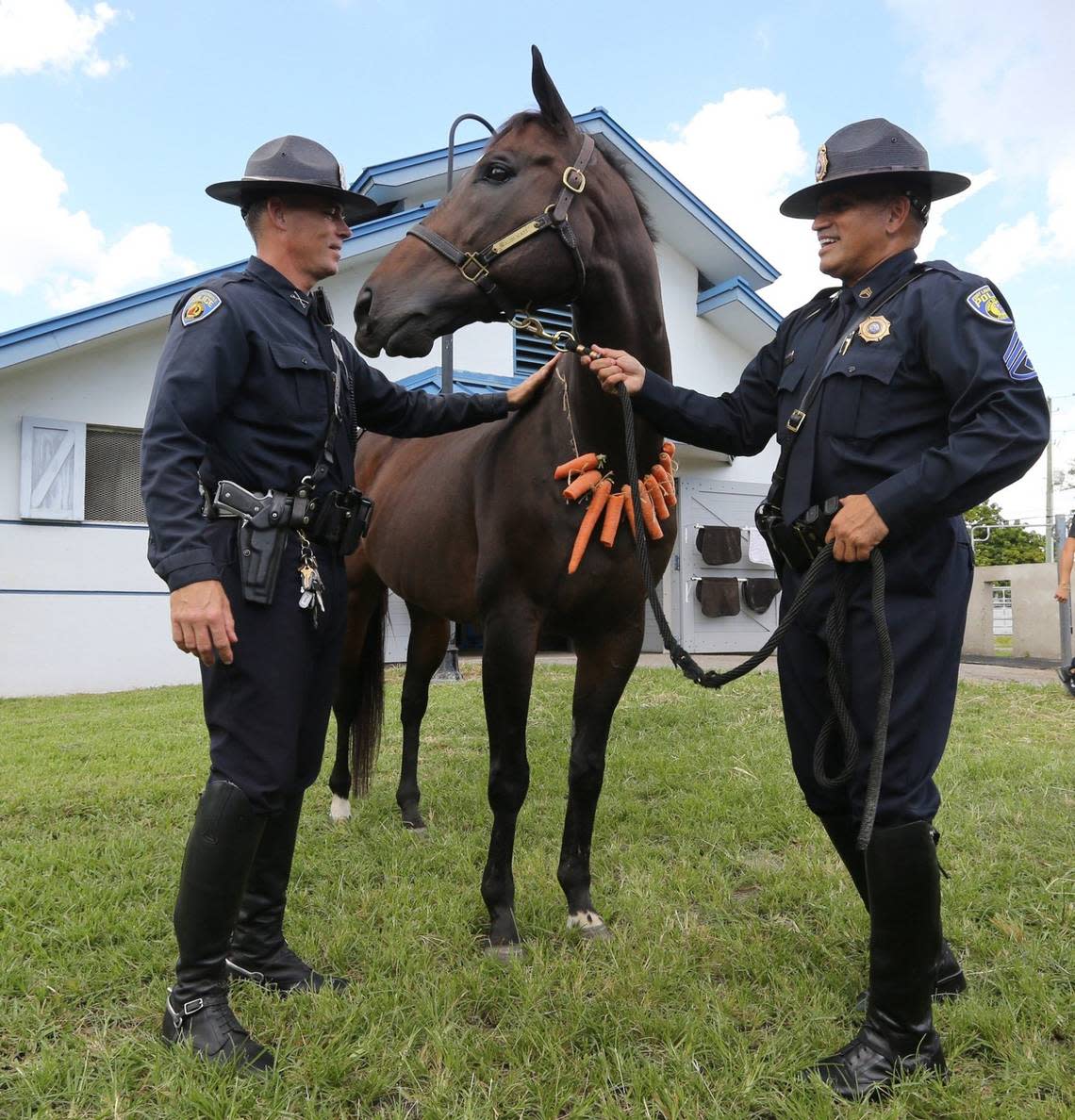

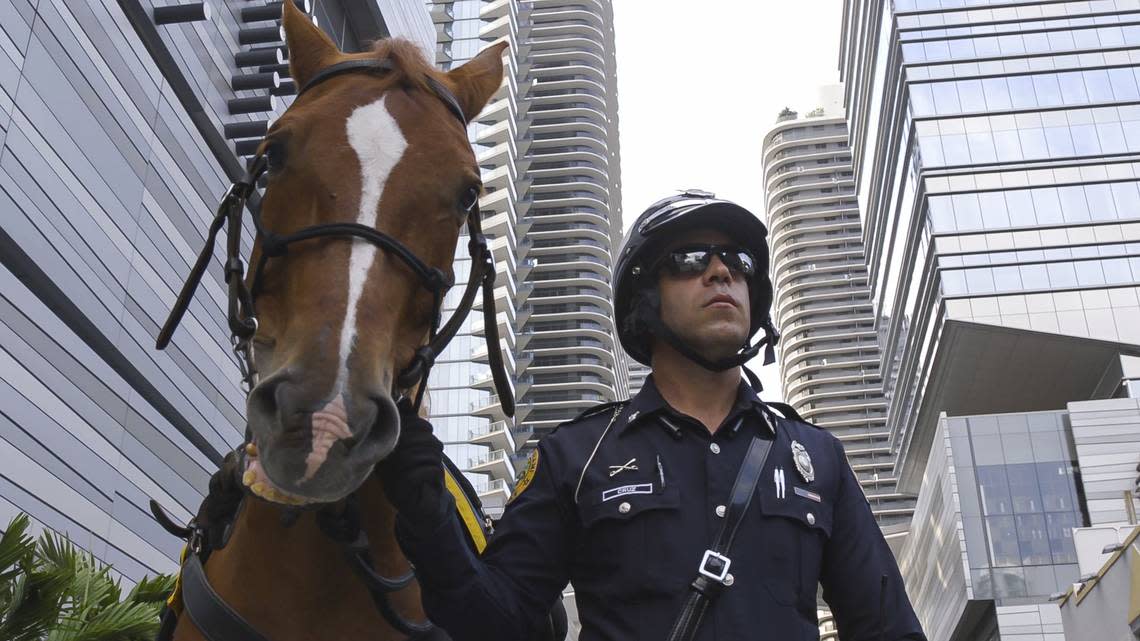
Policing in a positive light
Published Jan. 11, 1998
By Oscar Corral
They’re not the four horsemen of the apocalypse, but Broward Sheriff’s Office deputies on horses represent a fresh style of law enforcement in Broward.
“We run a show every day, and that’s what people want,” said Sgt. Mark Murray, who heads the BSO mounted unit.
People who slow down in traffic or sidetrack themselves in a sidewalk to take a closer look at police horses are living proof that mounted patrol officers are tops in community policing, Murray said.
“The interaction with people is what sets us apart,” Murray said. “When one of our deputies rides by on a horse, people come out of their homes to talk to us and pet the horses, and that’s exactly what we want.”
Murray is in charge of five deputies and seven horses, including Patton, Mr. K, Raindancer and Joe. Two more stallions are in training. All the horses are donated to the department by citizens.
After the working day, the stallions are loaded into portable stables and taken back to their home at Top Brass Farm in Sunshine Ranches near Cooper City.
BSO horses are all geldings, or castrated stallions. They are more level-headed and keep their thoughts on working, said Deputy Cea Milano, the only woman in the unit.
Milano, who has been riding since she was a girl, said she loves her job. When people pet her horse and marvel at its size, she feels proud.
“We still enforce the law. We still wear a uniform. But we’re in a very positive light,” said Milano, who has spent four years in the unit. “Everyone loves horses.”
The BSO started its mounted unit in 1990 with two deputies. It was the second department after Fort Lauderdale to get horses. Now Pembroke Pines, Coral Springs, Pompano Beach, Davie and Coconut Creek have mounted officers.
Horses can go where cars can’t, Murray said. He recalled instances when his horses have taken deputies through narrow alleys, into wooded areas, or between cars in traffic to chase suspects or investigate.
“Our deputies are perched 10 feet high,” Murray said. “We can see everything from up there. It’s ideal for crowd control or for patrolling parking lots.”
On Tuesday, deputy Ron Stewart sat atop his horse in front of the Ron Cochran Public Safety Building just outside of Fort Lauderdale. The wind nearly blew his hat off as his horse, Joe, clopped back and forth on the bricks. Several pedestrians stared at the animal.
“We keep very good relations with the community,” Stewart said. “Kids especially love the horses.”
Dawn Rubin, a civil division worker at the Public Safety Building, said seeing the mounted patrol was always a delight to her.
“I feel like they’re here to help the community,” Rubin said. “They’re right there at our reach.”
There is a down side to mounted patrol duty.
“The August heat is murder when you’re on a horse,” Stewart said.
And there is the matter of the sometimes sizable piles horses leave behind. If it’s on the beach, officers must dispose of it, Murray said. If it’s on the street, a sidewalk or a park, though, it stays, unless someone complains.
“It’s good proof that we’ve been there, Murray said. “And besides, it’s biodegradable.”
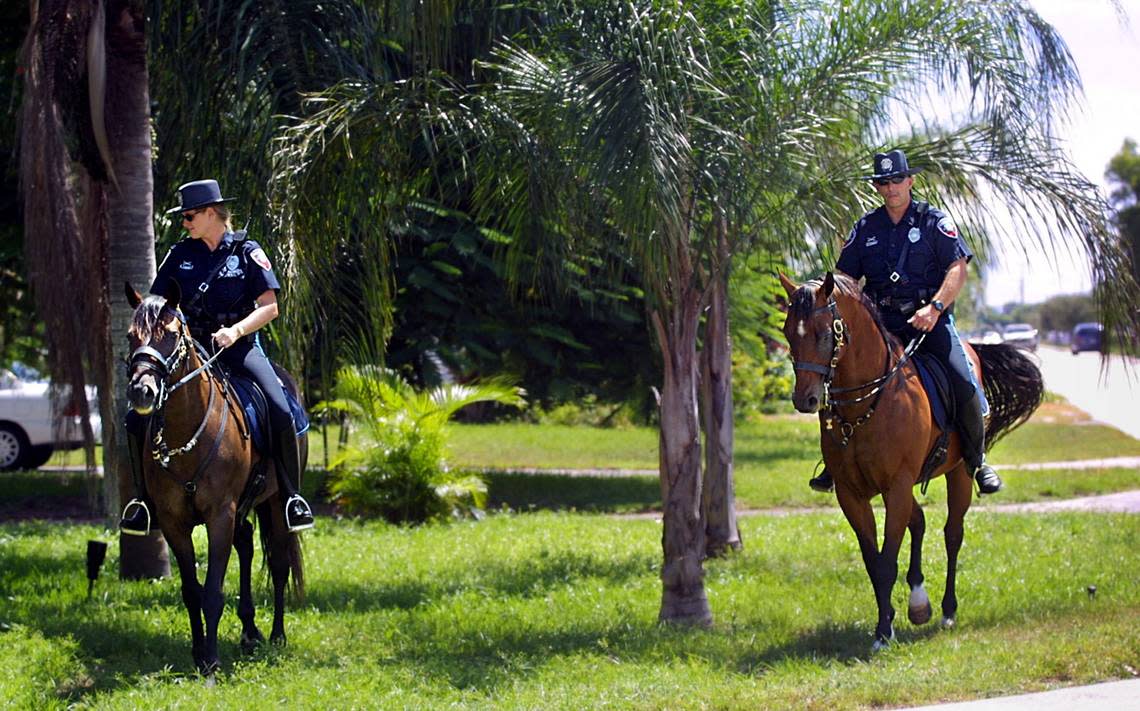
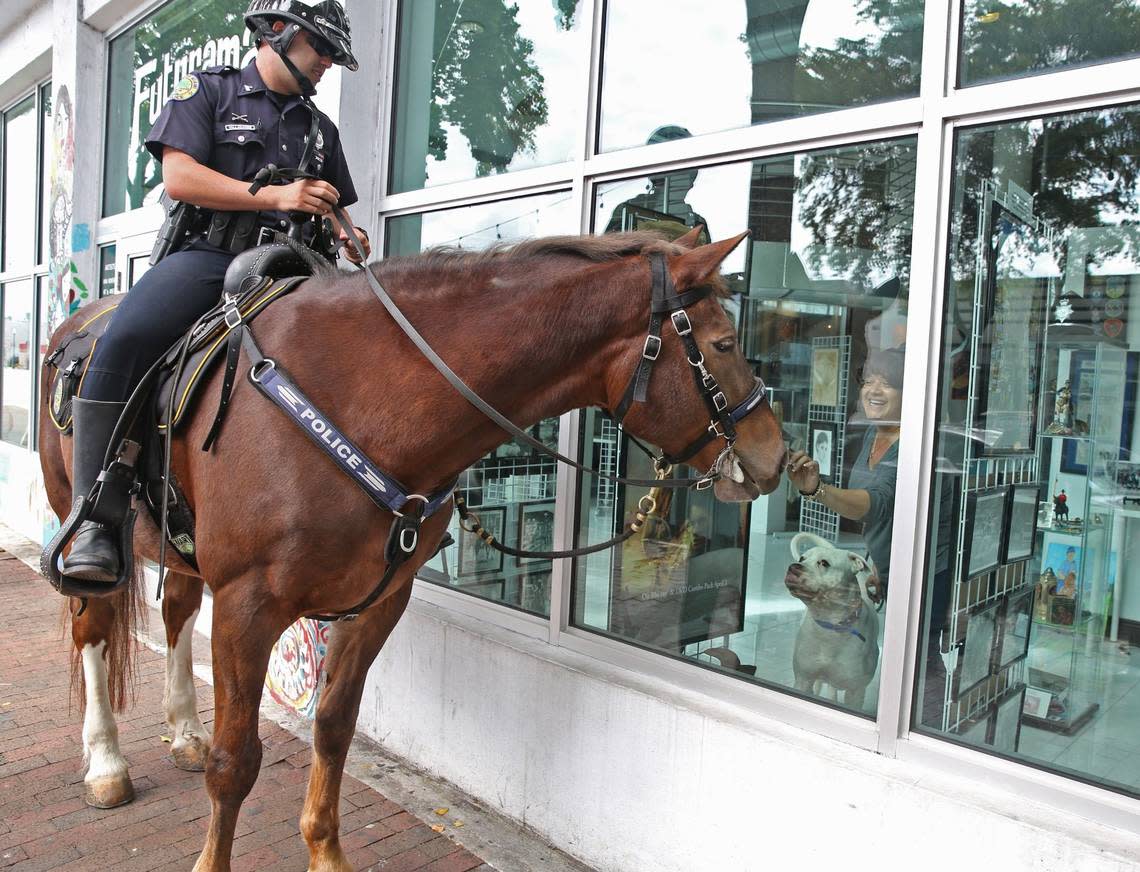
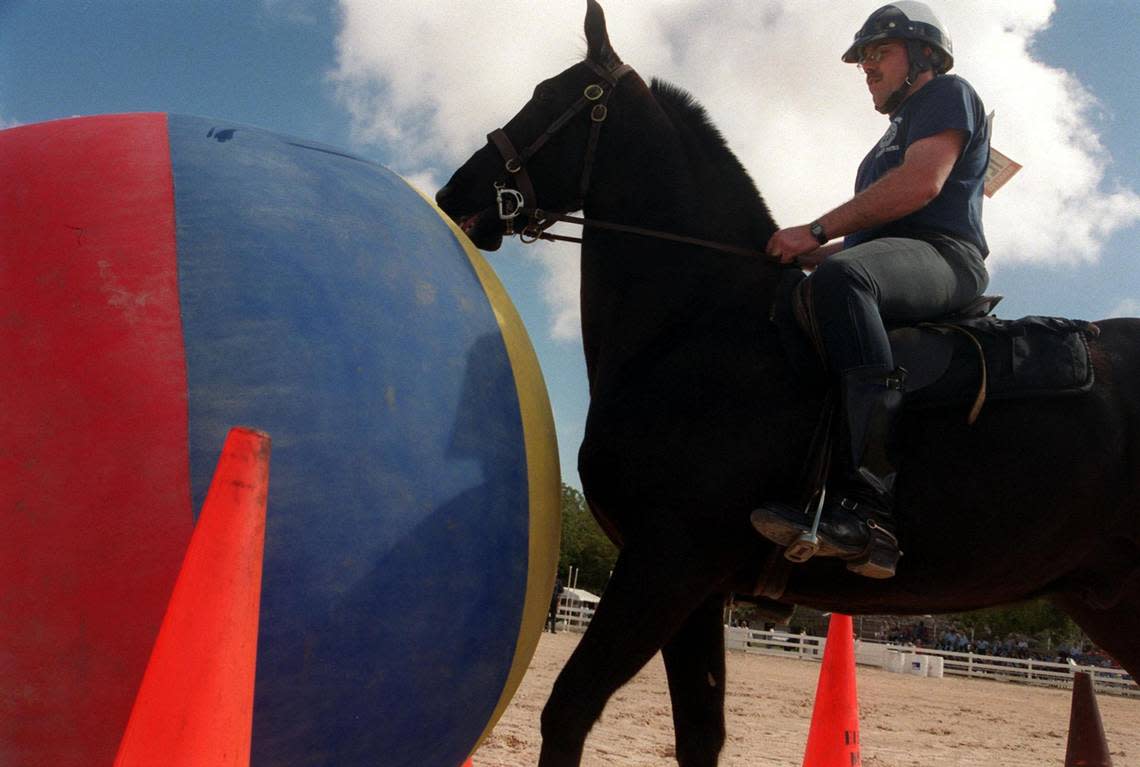
Horseback patrol not just for show
Published Nov. 27, 1989
By Lori Rozsa
The Palm Beach County sheriff’s mounted unit is most in demand for parades and festivals, but increasingly it’s the cavalry to the rescue in the department’s escalating war on drugs.
The nine men and one woman who comprise the unit, which was created in 1984, make 10 to 12 arrests a week, said mounted unit supervisor Sgt. Bret Sheets. Most are in parks and shopping mall parking lots they patrol on horseback.
Many of those arrests are drug-related, Sheets said, because people go to quiet, crowd-free county parks to use drugs.
“It’s easy to see what’s in the car when you’re sitting on a horse. You’re high up there and you can look down and see exactly what they’re doing,” said Sheets, 32. “We haven’t had as much of a problem with drugs in parks since we started patrolling on horseback.”
Besides the advantage of height -- some of the sheriff’s horses are taller than 8 feet from hoof to ear -- horses can go where cars can’t. The mounted unit is usually called in for searches in woods and fields.
Sheets wants to start using the horses to patrol neighborhoods where drugs are a problem.
“When you’re on a horse it’s much easier to get one-on-one with people than if you’re in a car,” Sheets said. “It helps you develop a rapport with people, and that helps you in police work.”
The unit has won a stable full of awards and ribbons, including first place in last year’s National Mounted Competition against police horsemen and women from 150 cities.
“If there’s anything that’s frustrating about this job, it’s that a lot of people don’t see us as law enforcement officers,” Breets said. “I guess it’s a concept that takes time to get used to.”
Five of the 10 horses in the sheriff’s department were donated, the other five were bought for around $2,000 each. The going rate for a horse of above average quality is $70,000 and up, Sheets said.
“But I don’t think taxpayers would go for that, so we use what we have as well as we can,” Sheets said.
The donations came from horse owners in the county who didn’t want or need the animals anymore. Sheets’ horse, Blaze, came from a stable in Delray Beach that trains race horses. Sheets said Blaze occasionally has the feisty temperament of a race horse.
But most of the high-strung behavior has been trained out of Blaze and the other horses. Now they’ll knock over a person on command by walking into them sideways, or walk into a crowd to break up a fight -- two things that go against the nature of the docile animals.
Sheets and the other riders said the horse is their partner. They feed it, groom it, train it and depend on it.
“Some of the bad guys think they can overpower a horse, and they’ve tried it,” deputy Bill Bruffey, 38, said. “It doesn’t work. They’re coming up against 2,500 pounds of an animal that will keep pushing and pushing.”
Jodi Spahr joined the mounted unit last week. Spahr, 25, spent three years as a road patrol deputy, and planned all along to apply for the horse corps.
“If you love animals, and you love being outside, and you want to be a deputy, this is the ideal job,” Spahr said.

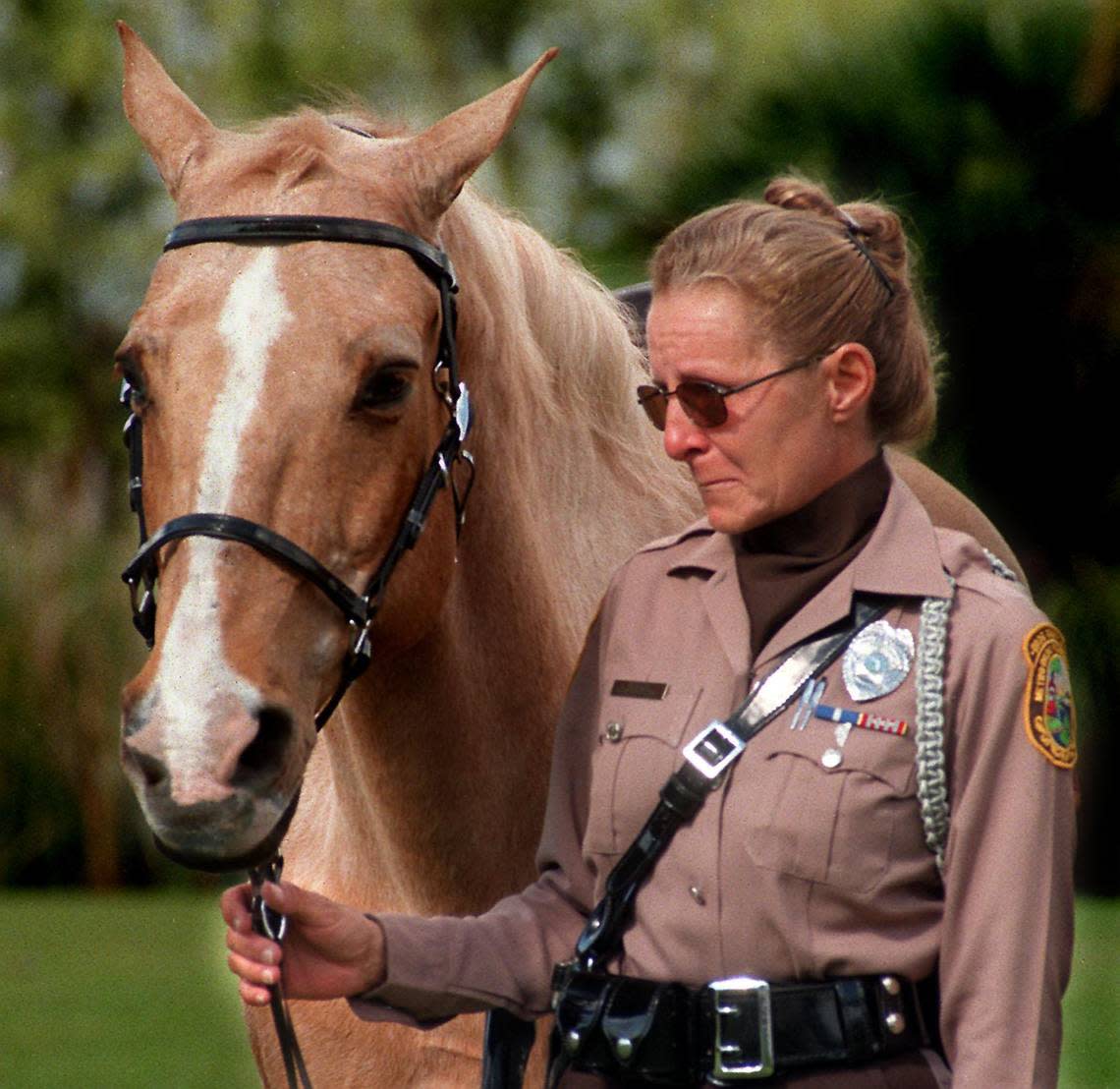
When the county had a horse patrol
Published Nov. 25, 1982
By Suzanne Spring
Miami has one. So does Miami Beach. So do Dallas, Boston and Atlanta.
Now, after two years of planning, unincorporated Dade County will have a “Mounted Unit” -- that galloping police unit usually called Horse Patrol.
The Metro-Dade Police and Parks departments -- who will pay for the patrol together -- made the announcement Tuesday.
Horse patrol is the best tool known to man for crowd control,” says Officer Bill Eades, who has helped plan the project for two years.
“The patrol’s public relations benefits are great,” he adds. “Have you ever seen anyone walk up and pet a police car? Well, people pet horses all the time, and then they get talking with the police officer...,” Eades says.
Police and parks officials hope to have four horse patrol officers on the road by mid-December.
First, they need a few good horses. They are looking for donations.
“We don’t care about color,” says Lt. James Touchton. “All we need is geldings taller than 15 hands.”
In its early stages, the mounted patrol will be confined to Tropical Park in Westchester and Crandon Park on Key Biscayne.
Tropical Park -- located between Bird and Miller roads and the Palmetto Expressway and SW 82nd Avenue -- covers more than a square mile. That’s larger than some small cities nearby, such as West Miami and Sweetwater.
In the past, the park has been troubled by teenagers who speed down its winding roads in Trans Ams and Corvettes.
Police say the park is also the scene of drug dealing and fights.
Crandon Park, with its sprawling parking lot, is a constant target for car burglars and robbers who prey on Miami natives and tourists alike.
Proponents think the horse patrol will the curb problems at both parks.
To prove it, they rattle off crime statistics gathered at last year’s Youth Fair in Tamiami Park, where Metro police used horse patrols for 18 days.
Compared to 1980’s fair -- which was one week shorter -- car burglaries decreased 30 per cent.
Arrests of car burglary suspects increased 500 per cent.
Eades, who says he “grew up riding horses,” likes to quote these figures: “It costs $5.73 a day to keep up a horse, that’s for feed, board, veterinarian and blacksmith care.
“It costs $55 a day to keep up a patrol car with gas and maintenance.”
For a final statistic, Eades offers: “I’m 1000 1/2 per cent behind this project.”
The new unit is being funded with $50,000 from the Parks Department and $75,000 from the police.
The Parks Department will keep the horses in the stables at Tropical Park, where it will supervise their care and exercising.
“We think the patrol will increase a sense of security at the parks,” says Parks Department Director Bill Bird.
“One person on a horse is worth three or four on foot.”
